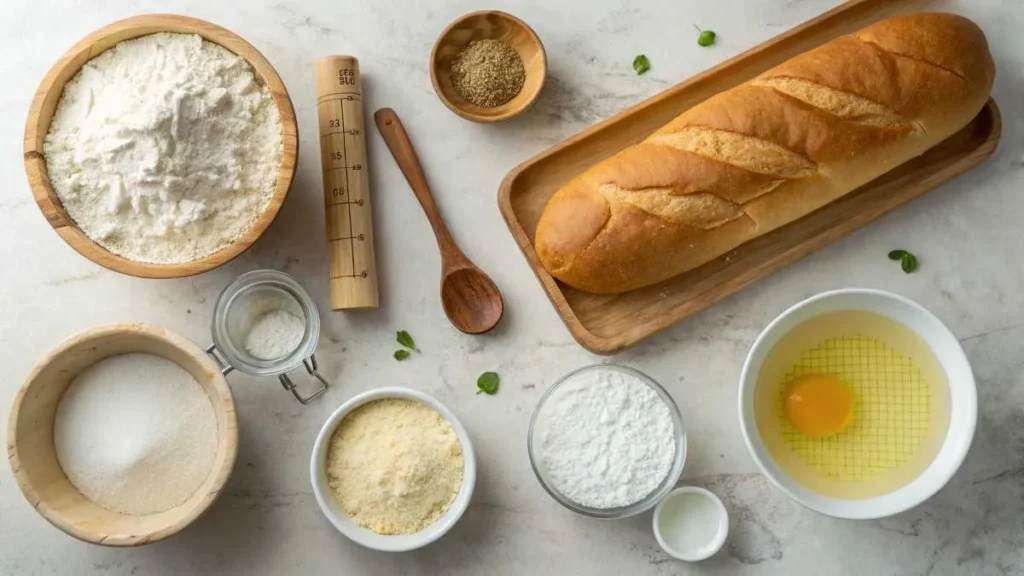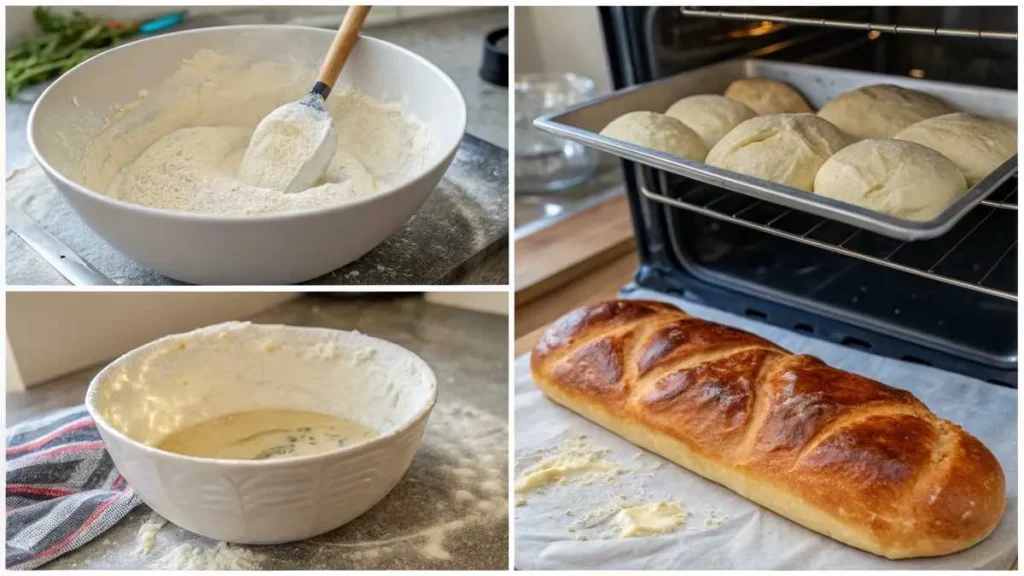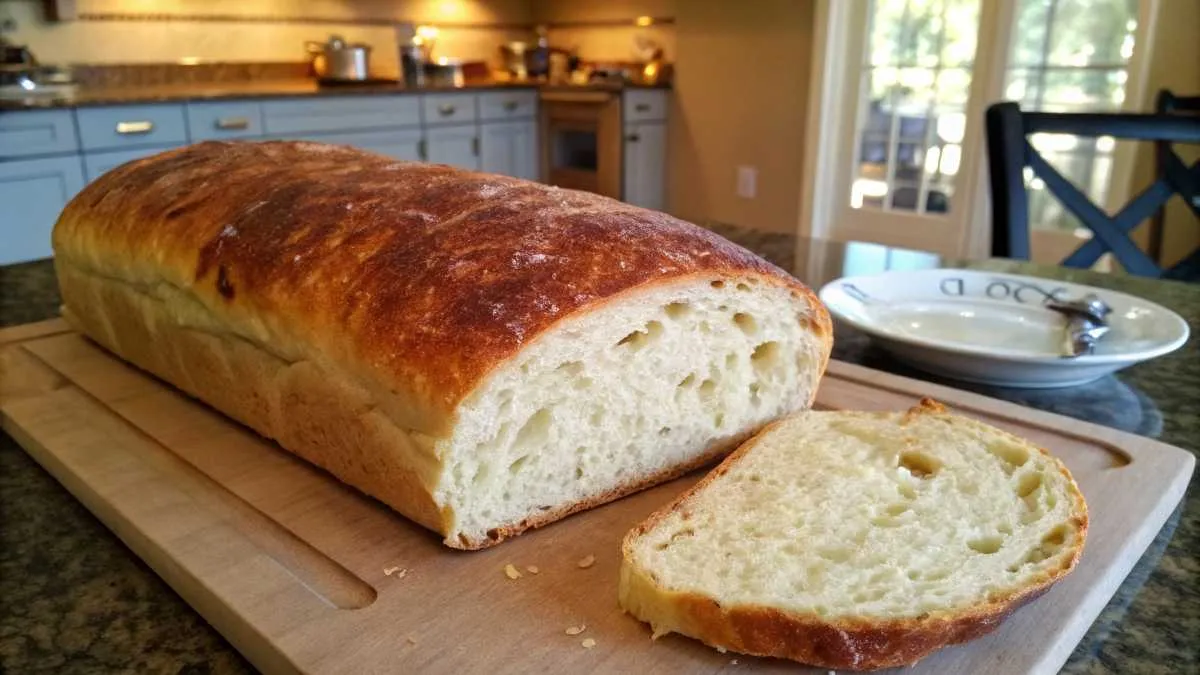If you’ve ever had an authentic Cuban sandwich, you already know that the bread is what makes it special. That crisp yet soft texture, the slightly chewy interior—it’s something you just can’t replicate with regular bread. But Cuban Bread recipe isn’t just for sandwiches. It’s a staple in Cuban cuisine, a part of history, and honestly, one of the best breads you’ll ever bake at home.
In this guide, I’ll take you through everything you need to know about Cuban Bread recipe, from its origins to a foolproof homemade recipe. Plus, I’ll share some tips, common baking mistakes, and how to keep it fresh longer.
So grab your apron—let’s talk Cuban Bread recipe!
Table of contents
- A Brief History of Cuban Bread recipe
- Understanding Cuban Bread Characteristics
- Essential Equipment for Making Cuban Bread
- Step-by-Step Cuban Bread Recipe
- Troubleshooting Common Cuban Bread Problems
- Variations on Traditional Cuban Bread
- Storing and Preserving Cuban Bread
- Serving Suggestions and Pairings
- Nutritional Information and Dietary Considerations
- Frequently Asked Questions About Cuban Bread
- Final Thoughts: Master the Art of Making Authentic Cuban Bread
A Brief History of Cuban Bread recipe
Cuban bread has deep roots in both Cuban and American history. Though its exact origin story is a bit fuzzy, it has been a beloved part of Cuban culture for centuries.
If you love exploring the roots of classic recipes, check out the history behind fried cabbage and sausage—another dish with deep cultural significance.
Origins in Cuba
Cuba has a long tradition of bread-making, influenced by Spanish and Caribbean techniques. Unlike traditional European loaves, Cuban bread is known for its simplicity—just a few basic ingredients come together to create something truly special.
One of the defining features of Cuban bread is its light, airy texture. This comes from a combination of high-hydration dough, fast fermentation, and the use of lard (or sometimes vegetable shortening) to give it that unique chew.
There’s also a long-standing tradition in Cuban bakeries: bakers place a palmetto leaf across the top of each loaf before baking. This isn’t just for decoration—it actually helps create the signature split in the crust, making the bread easier to tear apart and share.
Cuban Bread recipe in America
While Cuban bread was originally enjoyed in Cuba, it gained massive popularity in the United States thanks to Cuban immigrants. Tampa and Miami became hotspots for Cuban cuisine, with bakeries popping up to serve the growing communities.
Tampa, in particular, takes great pride in its Cuban bread. La Segunda Central Bakery, which has been baking since 1915, is one of the most well-known places for authentic Cuban bread. There’s even a bit of a rivalry between Miami and Tampa over who makes the best loaf!
One of the biggest reasons Cuban bread became famous in the U.S. is the Cuban sandwich. The combination of roast pork, ham, Swiss cheese, pickles, and mustard—pressed between slices of fresh Cuban bread—became a must-try dish. But Cuban bread isn’t just for sandwiches; it’s also perfect for breakfast, served with butter and coffee.
“In Tampa, Cuban bread is more than just bread—it’s a symbol of our heritage. Every morning, families head to their favorite bakery to grab a fresh loaf. It’s tradition.” — A Tampa baker
Understanding Cuban Bread Characteristics
What makes Cuban bread different from other breads? Let’s break it down. The light and airy texture of Cuban bread makes it a perfect base for sweet or savory dishes, much like this healthy apple crumble made with whole wheat flour.
Texture and Flavor Profile
Cuban bread has a thin, crispy crust that shatters when you take a bite. Inside, it’s soft, airy, and slightly chewy—perfect for soaking up butter or pressing into a sandwich.
Compared to French or Italian bread, it’s much lighter. The use of lard gives it a hint of richness, but overall, it has a mild flavor that makes it incredibly versatile.
Key Ingredients
The beauty of Cuban bread lies in its simplicity. You don’t need fancy ingredients—just a handful of pantry staples:
- Flour – Usually, all-purpose or bread flour works best.
- Water – Hydration is key to getting that perfect texture.
- Yeast – Active dry yeast or instant yeast helps the dough rise quickly.
- Salt – Adds flavor and helps with gluten development.
- Lard (or Shortening) – The secret to the bread’s signature texture.
That’s it! No sugar, no eggs—just the basics done right.
Essential Equipment for Making Cuban Bread
Before you start baking, you’ll need a few tools to make things easier.

Baking Tools
- Mixing bowls – One for dry ingredients, one for wet.
- Measuring cups and spoons – Accuracy is important when baking.
- Dough scraper – Helps with kneading and shaping.
- Baking stone or sheet – A baking stone gives you the best crust, but a baking sheet works fine too.
- Lame (or sharp knife) – For scoring the dough before baking.
Optional Specialized Equipment
- Stand mixer – If you don’t want to knead the dough by hand.
- Palmetto leaf – If you want to go the traditional route, you can place a palmetto leaf on top before baking.
“A baking stone makes all the difference. It helps give Cuban bread that perfect crispy crust. If you don’t have one, preheating your baking sheet works, too.” — A home baker
Step-by-Step Cuban Bread Recipe
Now that we’ve covered the history and characteristics of Cuban bread, it’s time to make it yourself! Don’t worry—it’s easier than you think. With just a few ingredients and some patience, you’ll have a fresh, homemade loaf that tastes just like the ones from a Cuban bakery. For a hearty meal alongside your fresh Cuban bread, try pairing it with this smoky and flavorful beef back ribs recipe.

Ingredients List
Before we get started, here’s everything you’ll need:
Basic Ingredients
- 4 cups all-purpose or bread flour
- 1 ½ cups warm water (about 110°F)
- 2 ¼ teaspoons (one packet) active dry yeast
- 2 teaspoons salt
- 2 tablespoons lard (or vegetable shortening)
Optional
- 1 palmetto leaf (for authenticity)
Preparation Steps
First, let’s get the dough ready. This process is straightforward, but timing matters.
- Activate the yeast – In a small bowl, combine warm water and yeast. Let it sit for about 5–10 minutes until it becomes frothy. This means the yeast is alive and ready to work.
- Mix the dry ingredients – In a large bowl, combine flour and salt. Stir them together so the salt is evenly distributed.
- Combine wet and dry ingredients – Pour the yeast mixture into the flour, then add the lard. Mix everything together until it forms a rough dough.
- Knead the dough – Turn the dough onto a floured surface and knead for about 8–10 minutes. It should become smooth and elastic. If it’s too sticky, sprinkle in a little more flour. If it feels dry, add a tablespoon of water.
- Let it rise – Place the dough in a lightly greased bowl, cover it with a towel, and let it rise for about 1 to 1 ½ hours, or until it doubles in size.
At this point, the dough should be puffy and ready to shape! Looking for a side dish to serve with your homemade Cuban bread? This red rice recipe adds a deliciously vibrant touch to your plate.
Baking Instructions
- Preheat the oven – Set your oven to 375°F. If using a baking stone, place it in the oven while preheating.
- Shape the dough – Punch down the risen dough to release air, then shape it into a long, thick baguette-like loaf. Place it on a parchment-lined baking sheet.
- Add the signature touch – If using a palmetto leaf, lay it across the top of the loaf. Otherwise, use a sharp knife to score a shallow line down the center.
- Final rise – Cover the dough with a towel and let it rest for 30 more minutes. It should puff up slightly.
- Bake – Place the loaf in the oven and bake for 25–30 minutes, or until the crust is golden brown and crisp.
Once it’s done, remove the bread from the oven and let it cool for at least 15 minutes before slicing.
“The key to great Cuban bread is patience. Letting the dough rise properly and using high heat during baking makes all the difference.” — A seasoned baker
Troubleshooting Common Cuban Bread Problems
Even experienced bakers run into problems, so don’t worry if your first loaf isn’t perfect. Here are some common issues and how to fix them.
Dough Not Rising Properly
If your dough didn’t rise much, a few things could be the culprit:
- Yeast was expired or inactive – Always check the expiration date on your yeast. If it didn’t foam up during activation, it’s likely dead.
- Water was too hot or too cold – Water above 120°F can kill yeast, while water below 100°F won’t activate it well. Aim for around 110°F.
- Room temperature was too cold – Yeast thrives in warm environments. If your kitchen is chilly, place the dough near a warm oven or inside a turned-off microwave with a cup of hot water.
Crust Too Hard or Too Soft
- Too hard? You might have baked it too long. Next time, reduce baking time by a few minutes.
- Too soft? The oven temperature might not have been high enough. A hot oven helps create a crisp crust.
Uneven Texture
- Dense and heavy bread? It’s likely the dough wasn’t kneaded long enough or didn’t rise properly.
- Large air pockets? This means the dough had too much time to rise, creating big bubbles. Try shortening the rising time slightly.
Variations on Traditional Cuban Bread
If you want to change things up, here are a couple of fun variations.
Whole Wheat Cuban Bread
For a heartier loaf, swap out half of the all-purpose flour for whole wheat flour. The texture will be slightly denser, but the flavor will be richer and more complex.
Garlic Cuban Bread
Love garlic? Add minced garlic to the dough or brush the crust with garlic butter after baking. It’s perfect for pairing with soups and stews.
Storing and Preserving Cuban Bread
Because Cuban bread doesn’t contain preservatives, it tends to go stale quickly. Here’s how to keep it fresh.
Short-Term Storage Methods
- Room temperature – Wrap the bread in a paper bag or a clean kitchen towel. Avoid plastic bags, as they make the crust soggy.
- Toast to refresh – If the bread starts getting stale, a quick trip in the toaster or oven can bring it back to life.
Freezing Cuban Bread
If you won’t finish the bread within a day or two, freezing is the best option.
- Slice the bread before freezing—this way, you can grab a slice whenever you need.
- Wrap it in plastic wrap, then place it in a freezer bag.
- To reheat, pop it in a 350°F oven for 10–15 minutes.
Serving Suggestions and Pairings
Cuban bread is delicious on its own, but it’s even better when paired with the right dishes.
Classic Cuban Sandwich
This is the ultimate way to enjoy Cuban bread. Layer roast pork, ham, Swiss cheese, pickles, and mustard inside the bread, then press it until crispy.
Other Delicious Ways to Enjoy Cuban Bread
- Breakfast favorite – Toasted Cuban bread with butter and café con leche is a staple Cuban breakfast.
- Side for soups and stews – The crispy crust and airy interior make it perfect for dipping.
- Garlic bread – Brush slices with butter, garlic, and parsley, then bake until golden.
“Cuban bread is more than just food—it’s a part of everyday life. From breakfast to dinner, it fits into every meal.” — A Miami chef

Nutritional Information and Dietary Considerations
Cuban bread is relatively simple, but here’s what you should know nutritionally:
- Calories – Roughly 70 calories per slice
- Carbs – Around 15g per slice
- Protein – About 2g per slice
- Fat – Low in fat unless buttered
For those with dietary restrictions:
- Vegan? Use vegetable shortening instead of lard.
- Gluten-free? Traditional Cuban bread contains gluten, but you can experiment with gluten-free flour blends.
Frequently Asked Questions About Cuban Bread
It has a thin, crispy crust and a soft, airy interior, thanks to lard and a fast-rising dough.
Flour, water, yeast, salt, and lard (or shortening)—simple but essential for the perfect texture.
Italian or French bread is similar, but Cuban bread is lighter and has a crispier crust.
The combination of lard, high hydration, and traditional baking methods gives it a unique flavor and texture.
Final Thoughts: Master the Art of Making Authentic Cuban Bread
Cuban bread isn’t just another loaf—it’s a piece of history, a staple of Cuban cuisine, and the secret to an unforgettable sandwich. Whether you’re making it for the first time or perfecting your technique, the key is using simple, high-quality ingredients and following the right steps for that signature crispy crust and airy interior.
From its origins in Cuba to its deep roots in Tampa and Miami, this bread has stood the test of time, becoming a beloved favorite in many homes. Now, you can bring that tradition into your own kitchen with this easy-to-follow recipe. Plus, with storage tips, common troubleshooting solutions, and creative variations, you’ll never run out of ways to enjoy it.
If you found this guide helpful, let me know in the comments—have you tried making Cuban bread before? What’s your favorite way to enjoy it? And if you’re looking for more delicious recipes, be sure to bookmark this page, share it with fellow food lovers, and follow for more traditional bread-making tips.
To further connect with the Cuban food community, follow our Facebook page for more delicious recipe ideas and baking tips.
